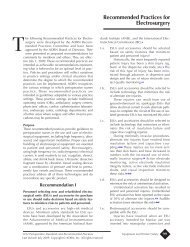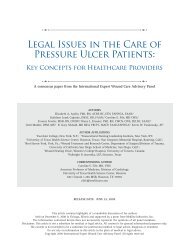2009 CAUTI guidelines - Centers for Disease Control and Prevention
2009 CAUTI guidelines - Centers for Disease Control and Prevention
2009 CAUTI guidelines - Centers for Disease Control and Prevention
You also want an ePaper? Increase the reach of your titles
YUMPU automatically turns print PDFs into web optimized ePapers that Google loves.
Very low-quality evidence suggested no benefit of a catheter team to prevent <strong>CAUTI</strong> amongpatients requiring intermittent catheterization. 274 This was based on one study showing nodifference in unspecified UTI between use of a catheter care team <strong>and</strong> self-catheterization <strong>for</strong>intermittent catheterization in paraplegic patients.Q2D.7. FeedbackVery low-quality evidence suggested a benefit of using nursing feedback to prevent <strong>CAUTI</strong>. 275This was based on a decreased risk of unspecified UTI during an intervention where nursingstaff were provided with regular reports of unit-specific rates of <strong>CAUTI</strong>.Q2D.8. Nurse-directed catheter removalVery low-quality evidence suggested a benefit of a nurse-directed catheter removal program toprevent <strong>CAUTI</strong>. 276 This was based on a decreased risk of unspecified UTI during an interventionwhere criteria were developed that allowed a registered nurse to remove a catheter without aphysician’s order when no longer medically necessary. Of the three intensive care units wherethe intervention was implemented, differences were significant only in the coronary intensivecare unit.Evidence Review Table 2D. What are the risks <strong>and</strong> benefits associated with differentsystems interventions?2D.1.a. Ensure that healthcare personnel <strong>and</strong> others who take care of catheters are givenperiodic in-service training stressing the correct techniques <strong>and</strong> procedures <strong>for</strong> urinary catheterinsertion, maintenance, <strong>and</strong> removal. (Category IB)2D.1.b. Implement quality improvement (QI) programs or strategies to enhance appropriate useof indwelling catheters <strong>and</strong> to reduce the risk of <strong>CAUTI</strong> based on a facility risk assessment.(Category IB)Examples of programs that have been demonstrated to be effective include:1. A system of alerts or reminders to identify all patients with urinary catheters <strong>and</strong>assess the need <strong>for</strong> continued catheterization2. Guidelines <strong>and</strong> protocols <strong>for</strong> nurse-directed removal of unnecessary urinarycatheters3. Education <strong>and</strong> per<strong>for</strong>mance feedback regarding appropriate use, h<strong>and</strong> hygiene, <strong>and</strong>catheter care4. Guidelines <strong>and</strong> algorithms <strong>for</strong> appropriate peri-operative catheter management, suchas:a. Procedure-specific <strong>guidelines</strong> <strong>for</strong> catheter placement <strong>and</strong> postoperative catheterremovalb. Protocols <strong>for</strong> management of postoperative urinary retention, such as nursedirecteduse of intermittent catheterization <strong>and</strong> use of ultrasound bladderscanners2D.2. Routine screening of catheterized patients <strong>for</strong> asymptomatic bacteriuria is notrecommended. (Category II)2D.3. Per<strong>for</strong>m h<strong>and</strong> hygiene immediately be<strong>for</strong>e <strong>and</strong> after insertion or any manipulation of thecatheter site or device. (Category IB)47
















